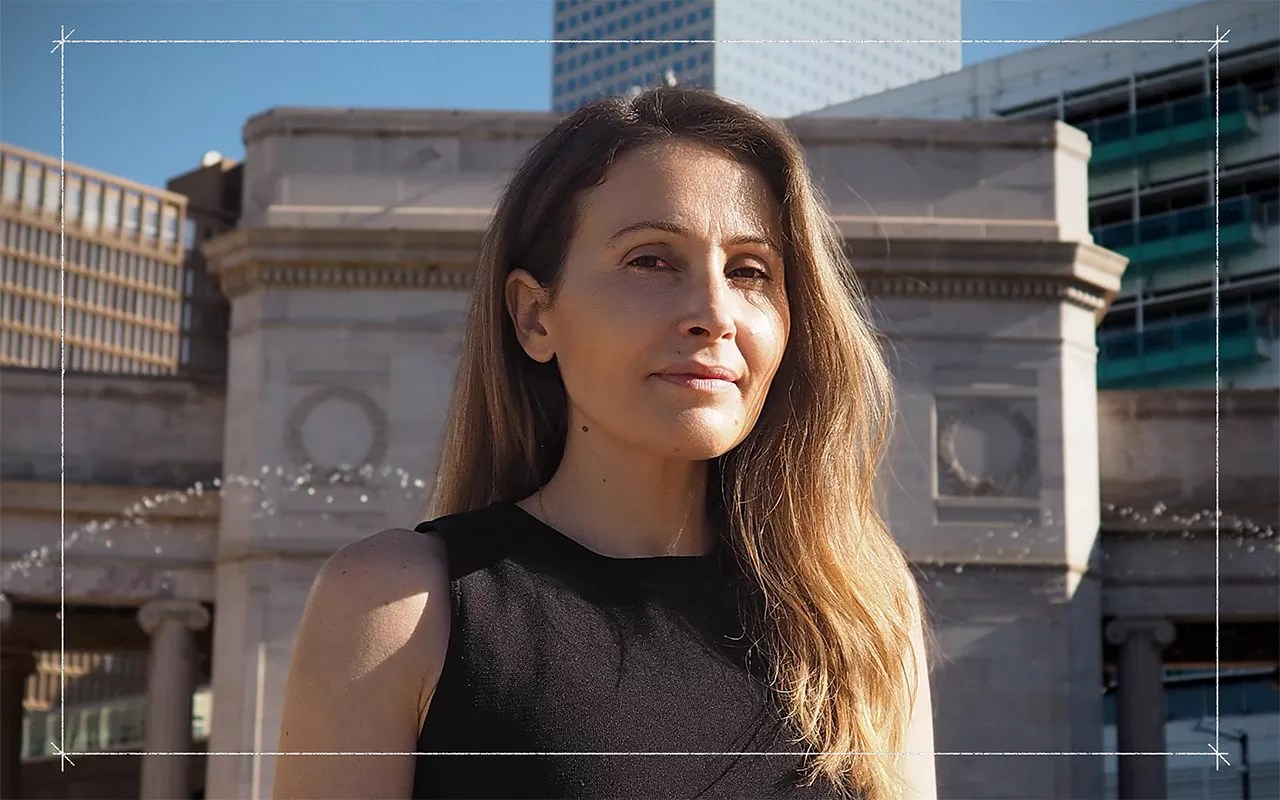
Westword

Audio By Carbonatix
On a hot, sunny Thursday in August, Eugenia Di Girolamo is cooling off on an RTD bus taking her from Confluence Park to the Civic Center area and her new office as Denver’s chief urban designer. Denver’s first chief urban designer.
Di Girolamo, a native of Italy, recently arrived in Denver from New York City, where she had been living in Brooklyn and working as the deputy director of urban design for the NYC Department of Planning. She’s excited that she snagged a cheap ticket to attend the pre-season match-up between the Broncos and Cowboys at Empower Field at Mile High.
“I want to figure out how to get there without driving,” says Di Girolamo, who lives in the Golden Triangle and tries to walk whenever she can to soak in the city’s pedestrian experience. “I’m wondering if it’s too far to walk. I think I can walk.”
She’s been walking a lot since she moved here. “I read a lot of local news – including Westword – but my preferred way to get to know a new city is to spend the time to walk, bike and talk to people. I’ve been doing a lot of that lately.”
Denver, make your New Year’s Resolution Count!
We’re $10,000 away from reaching our $50,000 year-end fundraising goal. Your support could be what pushes us over the top. If our work has kept you informed and connected this year, please consider making a contribution today.
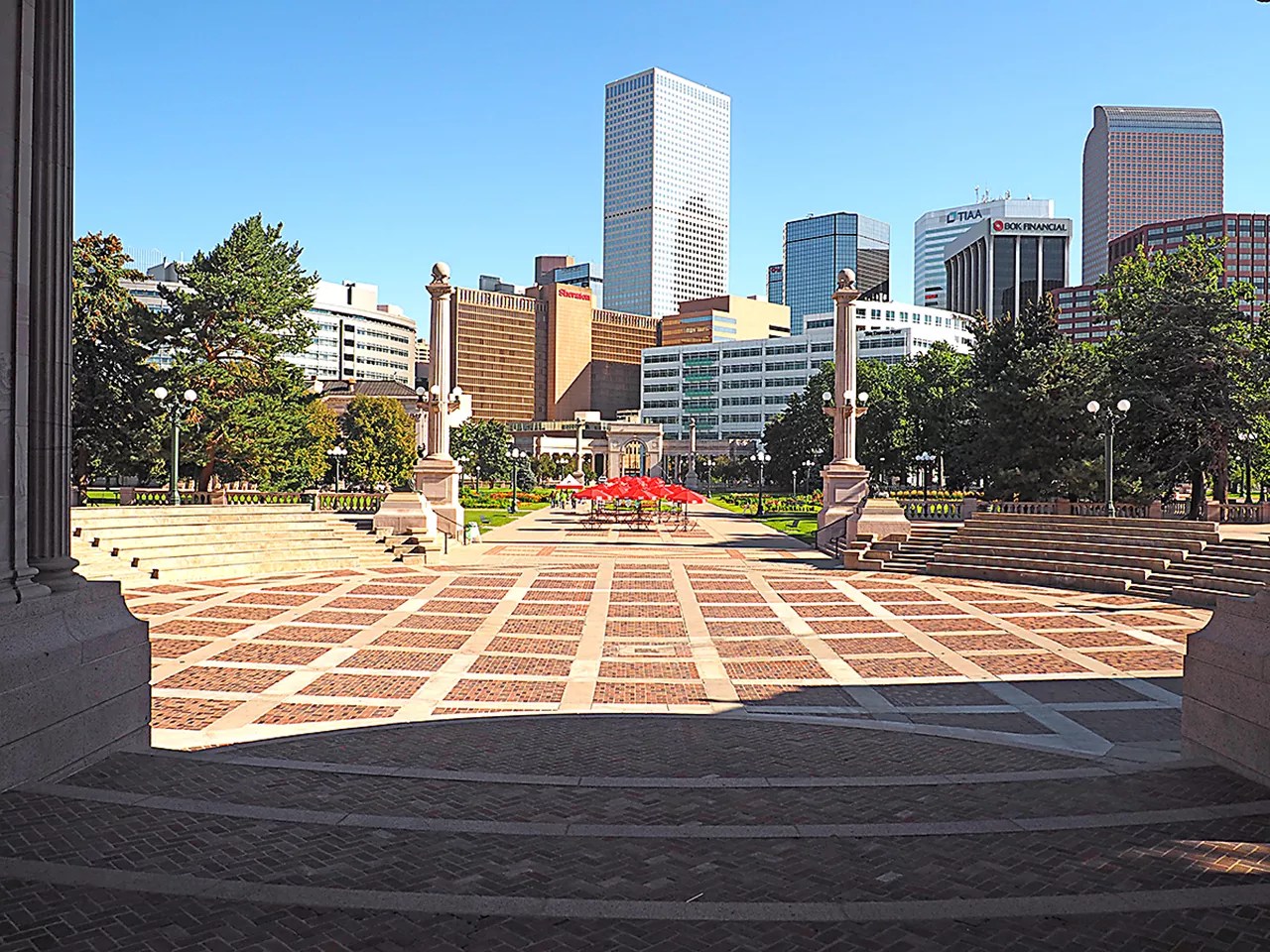
Civic Center Park at the heart of the city.
Westword
A trained architect, Di Girolamo hails from Pescara, a city on the Adriatic Sea that has gorgeous beaches. The 38-year-old loves the soccer club Inter Milan, and brings back huge containers of olive oil every time she returns from a trip to Italy.
Her interest in urban design was sparked by the vacations she took with her parents around Europe. “In the summer, we would drive everywhere, sometimes even to the north of Europe, because we couldn’t afford to fly,” she recalls. “But that was beautiful, because we would stop in a lot of cities along the way.
“Just growing up, I was able to see a variety of cities, the way they were developed, and a variety of cultures and countries,” she continues. “I think the proximity that you have in Europe to a diversity in built environments was really instrumental in me deciding to work at the urban scale.”
She studied architecture at the University of Bologna, where she feels she got a well-rounded education. In Italy, architecture schools teach the practice “at different scales, from the building detail all the way to just regional thinking and broader thinking,” she says. “I really appreciated that type of education, where it’s not as compartmentalized. … It really gave me a broader perspective about city-making and development in general.”
Di Girolamo, who also studied at the University of Southampton in England, started her career with the NYC Department of Planning through a summer internship in 2009. About two years later, the city brought her on as a full-time associate urban designer working on a range of projects, including flood resiliency and revitalization of transit-oriented developments. She eventually moved into a new role as a senior urban designer before spending a year as a fellow with the Urban Design Forum and about a year and a half with WXY Studio, an urban design firm, while also teaching urban design at Cornell University. After that, she went back to the NYC planning department, taking a job as a senior lead urban designer before ultimately becoming the deputy director of urban design.
During her work in New York, Di Girolamo stressed the importance of public engagement.
“I love to base my urban design approach on community planning and community engagement. I’m a firm believer in knowing the place first, visiting the place, listening to the people who live there and work there, understanding from them what are the issues that they face every day, how can the city help them, and how urban design can help them live better in the city they love,” Di Girolamo says. While at the department, she helped create a website that would help city residents better understand urban design projects.
“I love to base my urban design approach on community planning and community engagement.”
Urban design has been a mystery to many Denver residents for years as they’ve watched fugly developments spring up all over the city.
And while the City of Denver has employed urban designers over the years, it hasn’t had a high-ranking official focusing solely on urban design since long before Michael Hancock became mayor in 2011. And it’s never had a chief urban designer.
In 2019, Denver City Council adopted updates to Blueprint Denver, the land-use and transportation plan originally approved in 2002. It was through that process that it became very clear the Mile High City needed to create the role of a chief urban designer.
Later that year, after Hancock tapped Laura Aldrete, a Denver native who had worked on real estate development at Denver International Airport, to be the new executive director of the Denver Department of Community Planning and Development, she set a goal of hiring a chief urban designer.
“I have seen moments where we have focused on design and then we ebb away from it,” Aldrete explains. “I think we are in a moment where we are coming back to thinking about strong quality urban design in our public realm, and the moment is now.”
Urban design is the nexus of city planning with architecture and landscape architecture. And while architecture has been a profession since ancient times and city planning and landscape architecture have been their own professions for over a century, urban design has only recently been recognized as its own field.
“Urban design is less recognized as a discrete profession, at least in the United States, partly because it doesn’t have a corresponding professional licensure or national regulatory organization the way that the other three do,” says Ken Schroeppel, director of urban design at the University of Colorado Denver’s College of Architecture and Planning. “When you go to Europe, for example, and you talk to planners and designers who live and work in European cities, they really describe themselves more as urban designers than [ones that] have a technical expertise in one of those three fields.”
After pivoting to focus on other tasks during the first year of the pandemic, Community Planning and Development finally posted the chief urban designer job in July 2021.
A year later, the city hired Di Girolamo.
What stood out about Di Girolamo was her ability to heavily consider “community and social equity” in urban design, Aldrete says. “Those items aren’t often coupled together, and that was her starting point as she had the conversations with me and with the selection committee about where the urban design field should move. It felt like she was thinking about it from a 21st-century perspective.”
Urban designers think about the overall plans of a city while also looking at stylistic choices of individual developments and everything in between. The urban designer considers the lived experience for everyone who uses a city, including residents, tourists, commuters, pedestrians, bikers, transit users and drivers.
“In general, [it’s] thinking about people, their experience of the city, giving them services that they need, thinking about how they live in the city and how urban design actually impacts people’s lives – because where you live, your walk to work, your drive to work, your walk to school, whatever that may be, really has a social impact on your life,” Di Girolamo explains.
And an “equitable distribution of good and great design” across the city is of utmost importance. “I approach urban design from an engagement and equity perspective,” Di Girolamo adds. “I believe good city-building should be about people and their experience of the city where they live, work and spend free time. I clearly saw an alignment between my values and passion for community engagement and the values of Community Planning and Development. Denver already has a few urban designers on staff, which is great, and from my conversations with people on the city team and in the private and academic sectors, it was clear how much urban design was valued here. I found it refreshing and inspiring, and I’ve loved getting to know the people and places in Denver so far.”
But there’s so much more to see! This is only her fourth day on the job, and Di Girolamo has agreed to a tour of certain parts of Denver where urban design issues are front and center.
Laura Swartz, director of communications at Community Planning and Development, comes along for the ride…and walk. And while our travels are designed to collect Di Girolamo’s insights and observations about certain sites, some of the tour involves getting her up to speed on the background of certain locations and some of the major issues that Denver is facing. Our first stop:
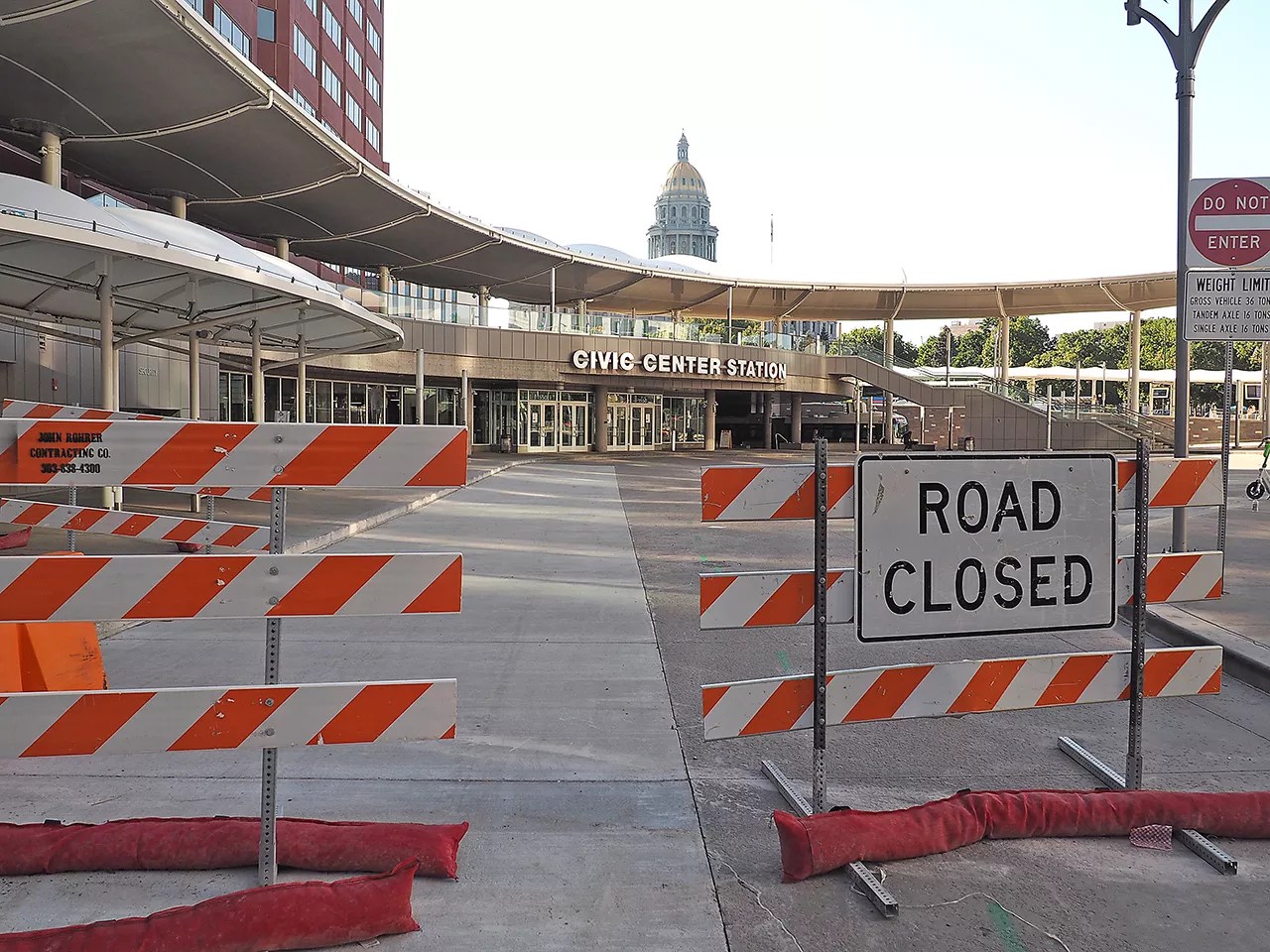
RTD’s Civic Center Station is not a welcoming spot.
Westword
Civic Center Station and Civic Center Park
Our tour starts at the northeast corner of Broadway and Colfax. “It would be interesting to understand how many lines come through here and how that would be serving the downtown,” says Di Giromalo, peering at the awnings of RTD’s Civic Center Station, which was renovated in 2017 after the transformed Union Station reopened as a multi-modal hub and RTD’s Market Street Station closed. “How you serve it now, and how you serve it in the future. I think investment in public transit is always extremely important for a city as large as Denver.”
Between the station and the corner is a barren lot filled with rocks and surrounded by fencing, which is owned by First Interstate Bank of Denver. What would Di Girolamo do with this space? “I think it’s tough to know right now,” she answers. “What I would do is really understand better the uses and the businesses and what’s around the site, and how the site plays a role in the area, and then just go from there, understanding the site and the area first.”
Across the street is a site much easier to understand. “We are in the Civic Center, and we know where we’re going,” she says. “It’s extremely important for a city to have spaces like this, where people can come together and express their minds and just enjoy a civic center or a center of the city.”
Civic Center got its start as part of Mayor Robert Speer’s City Beautiful project more than a century ago. But in September 2021, it was closed for safety issues; it had become a place where people hung out during the day dealing and doing drugs.
“I think that that’s definitely an issue that a lot of major American cities are dealing with at the moment, and I am sure it was exacerbated by COVID,” Di Girolamo says.
Although Civic Center is now open again during the day, like all Denver parks, it’s off limits after 11 p.m. Metal barricades remain on the perimeter so that the only way to enter is through specified entrances. The fencing is the type of barricade you might expect to temporarily control traffic flow, not the border you want for Denver’s crown jewel of its park system.
Di Girolamo doesn’t know much about the fencing, but speculates that it could be used for preserving the grass. “I think as long as there are points of entry that are clearly visible and allow everyone to come in and enjoy the park, I think that’s the most important thing, for sure,” she says.
I grew up just outside of New York City, and for a while, my mother has lived by Central Park, so I can swap New York experiences with Di Girolamo. While Civic Center Park is gorgeous and an important spot for events, I don’t think it’s the same type of park as Central Park. “I wouldn’t just go here with a buddy and be like, ‘Hey, do you want to go throw a Frisbee or a football at Civic Center Park?’ I don’t really feel like it’s thought of that way. It just seems like it’s not fully activated in a way that would have it reach its potential,” I tell her.
Di Girolamo has an intriguing response.
“It seems quite different from Central Park,” she agrees. “Central Park is a park within residential and commercial areas, but this is a more formal park that is surrounding the civic center. So to me, it’s great that something like this is actually experienced by people. People on their lunch break can come here. That’s really great.”
At this point, Swartz chimes in, suggesting that City Park is really Denver’s version of Central Park. And then it clicks for me: the zoo, the jazz concerts, the swan boats – City Park really is Denver’s Central Park.
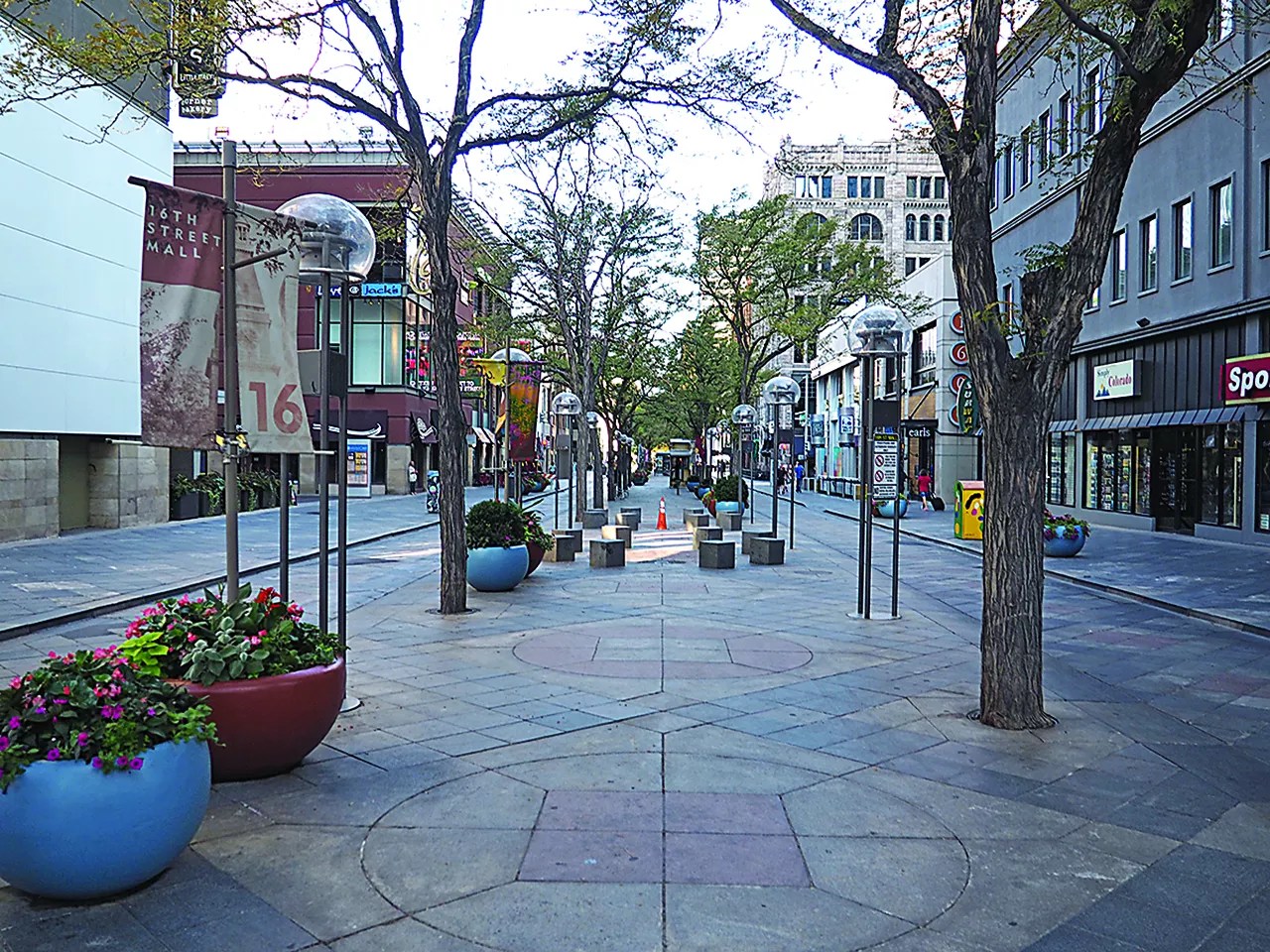
The 16th Street Mall is undergoing a major renovation.
Westword
16th Street Mall
As we head from Civic Center Park to the 16th Street Mall, Di Girolamo talks about some of her favorite European cities, with Rome in the summer at the top of the list.
“I grew up going to Rome on my school trips,” she says. “And I always loved how you can experience the very, very old and some of the new. There’s an extremely interesting mix of styles and experiences, and the city grew on top of that. And it’s always sunny, like it’s sunny here, so that’s great.”
Arriving at the mall, which is undergoing a major renovation after forty years, I tell Di Girolamo how it was “designed by the guy who built the glass pyramids at the Louvre.” Swartz offers “I.M. Pei,” to which Di Girolamo responds knowingly, “Ah. One of his buildings is right there.” It’s the hotel at 1550 Court Place that was a companion to Pei’s iconic hyperbolic paraboloid on the mall, which was demolished decades ago.
Pei also inspired the iconic, rattlesnake-inspired granite of the mall’s pavers, which are also endangered.
Swartz notes that the mall restoration project will replace the aging granite with a surface that is less slippery, moving transit lanes to the center so that spaces next to walkways can be better activated and add to the mall’s tree canopy. “How do we make this more of a place to linger and be, rather than just a place to walk through trying to get to your destination?” Swartz asks. The City of Denver is aiming to wrap up the project, which will cost $149 million, by the end of 2024; it’s being funded by a combination of local, state and federal dollars.
“A project like that really seems like it would be a great catalyst to start to get to that change that you were talking about,” Di Girolamo says. “I think that something that is great here is that at least you have some active uses on the ground floor, so there is a reason to come here already. And with improvement to the streetscape, hopefully that can just get better and better and better to the 24/7, the more activity you have just come in every hour of the day, during the week, the weekends.” You do have some stores, and you do have the restaurants, and you have offices close by. There are some residences. I think that the mix is there. I think it just needs to settle a little bit more and evolve a bit more. I’m really hopeful that the redesign of the mall will be a catalyst for that, for people…to linger, and not just come here and quickly get out.”
At the peak of the pandemic, parts of New York City lost almost all of their foot traffic, which Di Girolamo got to see up-close and personal. The problem has been exacerbated in other cities with central business districts that are one-trick ponies, she notes: They have commercial spaces without as much residential and with largely unactivated ground floors, and that creates the feeling of a ghost town when workers aren’t coming into the office as much.
Some of this can be ameliorated by activating the ground-floor areas and also converting commercial spaces into residential units, which Di Girolamo was helping to do in NYC and which has already started here in Denver.
“You do need the restaurants, you do need the residents,” she says. “You need the businesses to keep an area alive and active – really trying to strive for that 24/7 activation that makes a city center vibrant.”
City centers were facing challenges before 2020, but the pandemic just heightened them. “Like many other large American cities, Denver is facing an evolution in the way we work and experience the public realm following the COVID-19 pandemic,” Di Girolamo notes. “This, of course, has repercussions throughout the city, not just in the core, and will require us to think creatively and work collaboratively about how we bring life back to downtown, ensuring that it becomes a lively, safe and inviting mixed-use place that all Denverites can enjoy and feel proud of.”

Union Station gets points from Di Girolamo for its capacity as a public space.
Westword
Union Station
We head down the mall to Union Station, which was highly recommended to Di Girolamo before she ever got to the Mile High City. “I’ve asked a few people what their favorite place in Denver is so I can check it out,” she says. “And a person said that the station and outside it is their favorite place because it’s really a place where you can just go and hang out, and you don’t have to necessarily consume anything, or if you want, you can. It’s a place that really allows everyone from the city to come and enjoy a public space. I think that answer was very heartfelt.”
But that answer was not complete. The Great Hall at Union Station, once billed as “Denver’s living room,” is not as accessible these days. Security guards have been cracking down to make sure that the bathrooms are used only by paying customers, which is not the case at Grand Central Station in New York City.
While the renovation of Union Station, with its restaurants and upstairs hotel and big open space, has been hailed as a major success, there have been more issues with the bus station that was installed at the back of the building. Over the last eight months, the Denver Police Department has been keeping a close eye on “homeless individuals who congregate and shelter there, becoming prey to drug dealers.” Entrance to the bus terminal and its facility is now limited to passengers; RTD is installing gates.
After enjoying the ambience of the Great Hall, we walk outside and across the tracks to the back of Union Station and the bus terminal.
“It feels relatively seamless to me,” Di Girolamo says, praising the transition.”It feels very approachable.”
She’s happy to see taller residential buildings around the back of Union Station, in what was once a dusty railyard, and praises some of the nearby businesses, including a restaurant, that have spilled onto the sidewalk and street.
“I think density is always great around transit – to really make sure you’re capitalizing on transit infrastructure and really enticing more and more people to use it because it’s so conveniently located,” she says.
But Di Girolamo does wonder whether some of the ground floors of buildings around the back of Union Station could be better activated.
“In urban design, something that we’re always striving for is activating the frontages as much as possible with uses, but also, from a design perspective, making sure that we don’t have blank walls,” she explains. “We really limit the amount of entrances to parking from the major streets. When you have businesses that face the street and you can see inside and out, you really feel a lot more safe, and you’re willing to go a little bit further by walking, and you’re going to decide to not take your car as much.”
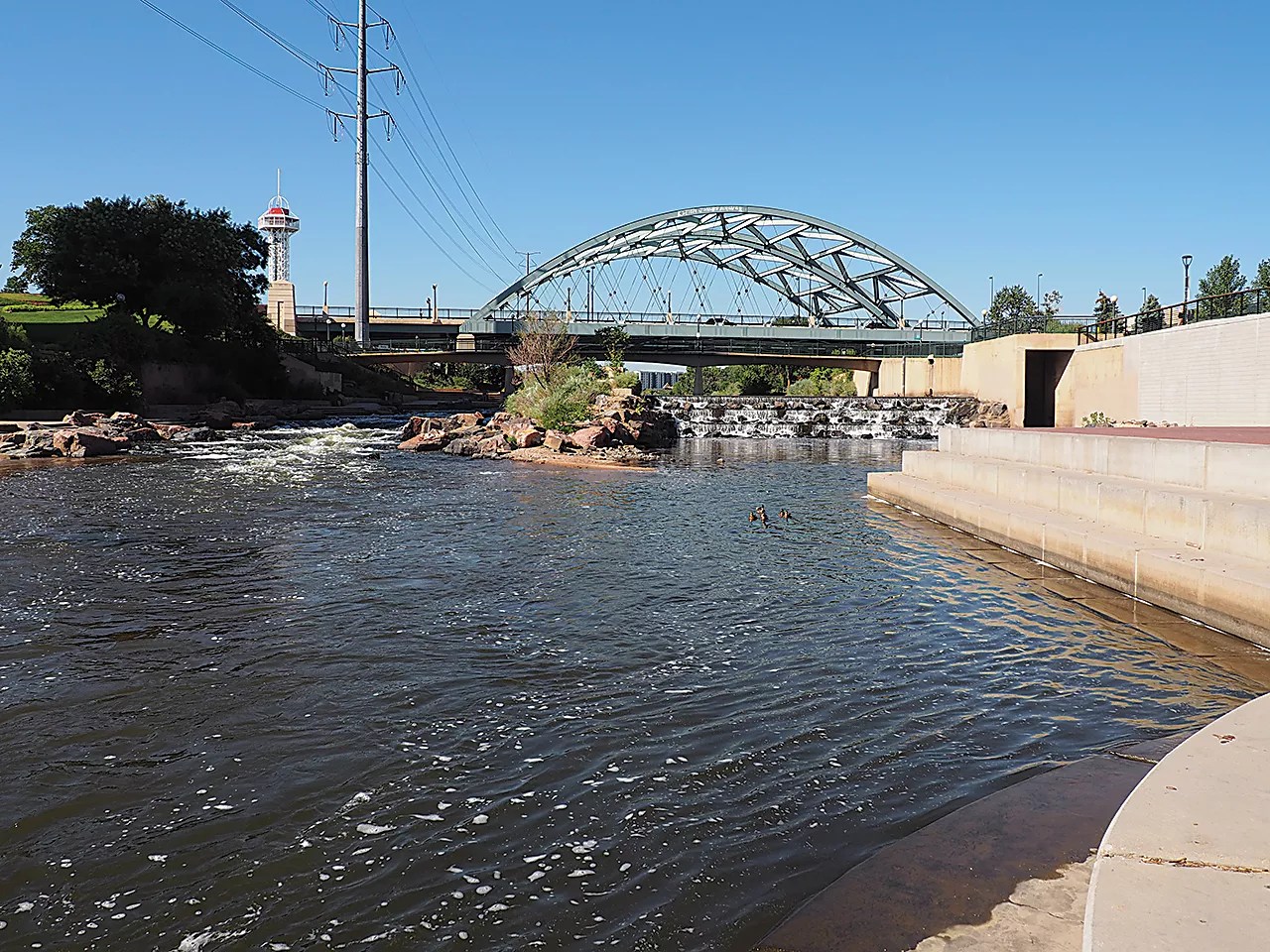
Di Girolamo proclaims Confluence “a gorgeous park.”
Westword
Confluence Park
Continuing into the Central Platte Valley, we stroll over to Confluence Park, close to where gold was discovered and Denver was founded over 150 years ago. We start talking not just about the city’s past, but about how Di Girolamo envisions some of the work she’ll be doing for its future.
“The way I worked in New York is that I was able to work on all aspects of planning, so both from visioning studies [and] rezonings, but also application review and inter-agency coordination,” she says. “So I do think that urban design expertise and an eye on a project could be helpful at any stage.”
A friend had told her she needed to check out the flagship REI store in the old tramway building next to Confluence Park, so she’s already been in the area. Di Girolamo plans to buy hiking shoes from REI soon, since she didn’t have any back in NYC.
As we gaze at the people staying cool as they splash around in the South Platte, Di Girolamo proclaims that “it’s a gorgeous park.” And that gets her thinking about something else that makes Denver special.
“Driving, sometimes you get a view of the mountains, and it’s so nice,” she says. “I do love that about Denver. You are in the city, that urban environment, but you can still see the mountains and get reminded that they are there and that they’re so close by.”
The confluence of two waterways in the heart of the city was another pleasant surprise. “I love how Cherry Creek and Platte River trails offer a great commuting route for many people in Denver,” she notes, complimenting the “infusion of the work from local artists in public spaces in many of the neighborhoods I visited so far.”
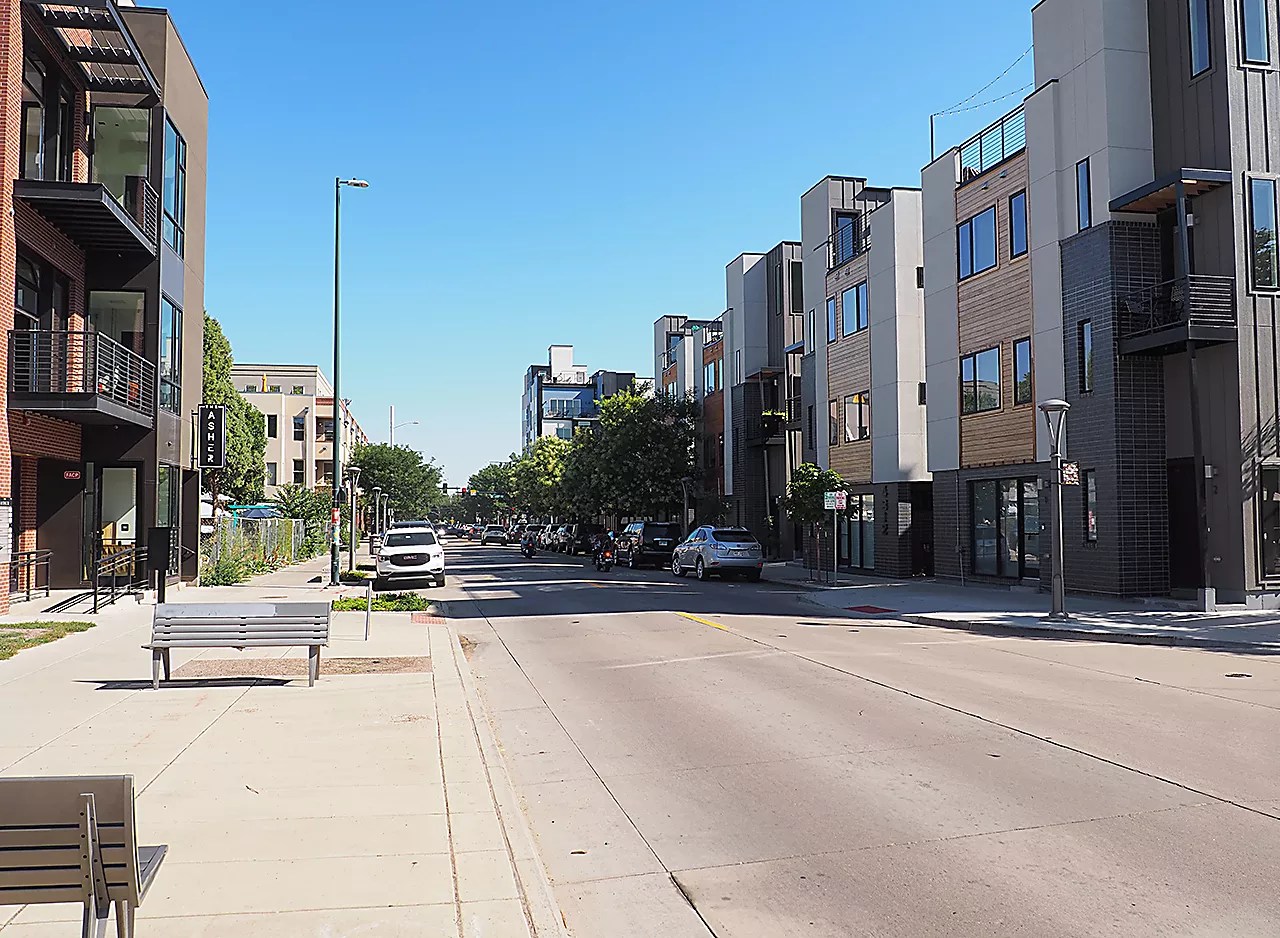
The new urban design chief has some suggestions for Tennyson Street.
Westword
Tennyson Street
With RTD free for the month of August, we hop on a bus bound for Civic Center. “Public transit in Denver is a great asset,” Di Girolamo notes, “and I would love to see service expand as more people use it to get around. It is important to capitalize on the existing and planned transit access so that new development can be less reliant on car use.”
Still, we get in Swartz’s car to head over to Tennyson Street, one of the neighborhoods that has become ground zero for the city’s current urban design debates.
One of the worst aspects of new development in the area over the past decade or so has been the construction of slot homes. The term is unique to Denver, but the concept is not: A slot home is a “multi-unit residential structure consisting of attached dwelling units arranged side-by-side and primarily perpendicular to the street,” according to Community Planning and Development.
Developers began building hundreds of slot homes along Tennyson after Denver City Council adopted the 2010 zoning code. While council essentially banned the construction of slot homes in 2018, there were plenty already in place.
While the slot homes have damaged the main-street appeal of Tennyson, Di Girolamo has some suggestions to improve on the situation.
“Something in New York that we were trying to do a lot, especially with affordable-housing buildings where we’re trying to maximize envelopes as much as possible, is really looking at the ground floors and understanding how can we place a unit slightly more elevated so you don’t get that window right at the eye level and then activating the street,” she says. “It’s a side street, so you don’t have that commercial use, so how do you do that through design? With planting, with architectural details.”
And what’s happening on Tennyson is mirrored in many parts of Denver, where developers continue to build. “Part of my role will be to support the city’s development review process with the goal of delivering great design across Denver,” notes Di Girolamo. “It’s not only about aesthetics, but also especially about how a building meets the street, for example, how new development complements existing buildings and structures and helps contribute to the sense of place and belonging of a particular neighborhood, how services and different uses, like stores, are distributed across a site, to name a few.”
The hiring of Di Girolamo comes at an important time for Denver. Judging from current population trends, the Mile High City is just going to keep growing. To prevent it from becoming just another city in the U.S., thoughtful urban design has to be at the forefront of this growth.
“That’s why having an urban design director for the city is going to be really helpful,” says Schroeppel. “Because now there’s a person whose job is specifically to focus on some of these big-picture questions and to help lead the city forward in this area.”
Adds Aldrete, “The layer we’re adding to that is, how do we do that in an aesthetic way? How do we ensure an authenticity so that Denver is unique as a city geographically located in the continental USA, and our history is unique? I think we are just leaning into that to ensure that we have that continued authenticity that shows up in urban design.”
On August 13, the Broncos treated Di Girolamo to a 17-7 victory over the Cowboys.
Denver’s first chief urban designer walked from her home in the Golden Triangle to the stadium, then took a scooter back.
“The commute was smooth. I thought the bike lanes connecting to and from the stadium area were great,” she says.
“I look forward to getting my boots on the ground, experiencing all the great neighborhoods of the city and hearing directly from the people in Denver about what is important to them when it comes to the built environment in their city,” she adds.
“What I would love to do here, first and foremost, is just walk everywhere or just visit all the neighborhoods and talk to folks’ communities or architects and developers, but also community representatives and elected officials, and also people on the street. What is their experience of Denver, and what would they like it to be?”